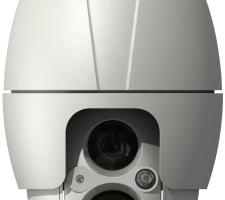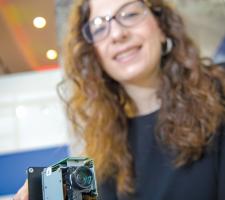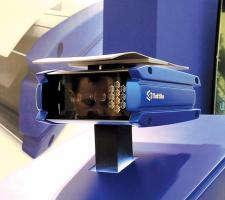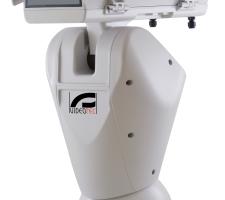
Colin Sowman considers some of the latest advances in camera technology and transport-related
vision technology applications.
Vision technology in the transportation sector is moving apace as technical developments on both the hardware and software sides combine to make cameras more multifunctional with a single digital camera now able to cover a multitude of tasks.
A good example of this is
“You cannot detect the speed of a vehicle 250m away through optical means alone because there are not enough pixels to determine the speed, but this is not a problem for radar,” said Flir’s Robin Collaert.
‘Virtual loops’ can be created in each lane both to identify vehicles driving or waiting in the dilemma zones. Separate truck and car dilemma zones can be created for each lane and, combined with the vehicle speed, the system can determine if the green signals for crossing traffic, cyclists or pedestrians needs to be delayed to prevent a red-light running incident. Once vehicles have stopped, they no longer register on the Doppler radar so the visual detection takes precedence.
Speeding vehicles can also be detected at a distance far enough away to allow the lights to be turned to red to bring them safely to a halt.
According to the company, the system not only improves safety and efficiency of the intersection, it can also replace up to five loops in each lane. The combined camera/radar unit can be positioned on existing infrastructure either side of the intersection without significant loss of performance.
Flir has also introduced the TrafiOne Smart City Sensor; an all-round detection sensor for traffic monitoring and dynamic traffic signal control. This combines thermal imaging and Wi-Fi tracking technology to provide traffic engineers with high-resolution data on vehicles, bicycles and pedestrians at intersections and in urban environments.
The thermal imaging can detect pedestrians and cyclists approaching or waiting at the kerbside or walking on a crossing and is connected to the traffic signal controller to allow for a more dynamic control of traffic signals.
Thermal imaging cameras are used because they work in total darkness and are not affected by shadows or glare while the optional Wi-Fi tracking technology can be used to capture traffic flow data.
According to Stefaan Pinck, Flir’s VP of worldwide ITS sales, the data collected by the TrafiOne sensor, will help traffic engineers adapt traffic signal schemes, reduce vehicle idling time, monitor congestion, enhance safety for vulnerable road users and measure travel and delay times for different transport modes.
Another example is
According to Massimiliano Cominelli, sales manager for Tattile’s Traffic Division the new cameras “Address both the immediate and future requirements of the ITS market.”
Vega Basic cameras can read both reflective and non-reflective number plates without illuminators and their PoE (Power over Ethernet) technology allows a single-cable installation.
It comes in colour and monochrome versions and like other Tattile products its processor, ANPR software and web server are integrated, making the camera self-dependent.
Vega Smart has a more powerful processor, uses the latest generation sensors and has two different OCR software packages to improve recognition rates. It comes in dual- and single-head versions and can recognise the brand and colour of vehicles and optically classify them while also generating high-quality video. The system is said to be fully scalable and offers high added-value without forcing users to buy all the required functions at the outset.
For
“It’s got a powerful zoom lens but you will still get stable images even when you zoom in on your subject,” said Tamron graduate engineer Velina Zhekova. “Normally, the more you zoom in on something, the more that vibration will affect the image. But not with this product.
“We are only just starting to work with partners to evaluate the product and we are looking for their feedback,” said Zhekova, adding: “So far all the feedback has been amazing.
High-resolution remains a key ingredient for vision technology applications, and that remains a challenge in the transport sector with the combination of fast-moving objects and variable lighting conditions.
Dale Deering, director of vision product development at
To enable the transfer of these ever-bigger volumes of data the company has added a TurboDrive operating mode. This speeds up line and frame rates beyond the nominal link capacity and enables the system to exceed the gigabit Ethernet speed ceiling in order that GigE Vision cameras can send pixel information at a rate in excess of 125mbps.
Deering: “TurboDrive ensures data can be transmitted at high speeds across long distances using inexpensive data cables. With Trigger-to-Image-Reliability, these same integrators are assured that the camera is always capturing all of the expected data, and transferring it reliably to the host, or can rapidly diagnose issues.”
Also on the high-resolution theme is
Coupled to an Intel NUC host computer running National Instruments Measurement and Automation Explorer (MAX), the unit captures full resolution images at 12 frames per second (fps) with full colour and a linear dynamic range of up to 82dB.
The company’s ‘Dual-Gain High Dynamic Range’ (HDR) implementation processes the same high-resolution frame through two different gain amplifiers to produce a merged HDR image without introducing image blur.
Also featuring a new sensor is
Available in monochrome or colour versions, the cameras can be fitted either with a Camera Link or a Gigabit Ethernet interface and do not require any external cooling thanks to their intelligent heat management system.
Grundig Security highlights the low light performance of its latest new 3MP, IP bullet, vandal, dome and box cameras. Central to this performance is
The bullet and dome cameras use Tamron 3x optical (3.0 to 9.0mm) auto-focus zoom lenses (F=1.3 ~ 360) with 10x digital zoom. With P-Iris (‘precise iris’) as standard in the lens models, image contrast, clarity, resolution and depth of field are all increased.
A ‘Dual Shutter WDR’ (wide dynamic range) feature allows the exposure and gain, in consecutive frames to be individually adjusted and merged to enhance image quality in most high-contrast lighting conditions. The bullet and vandal dome are both IP66 protection-rated and IK10 vandal-rated and have an operating range between -40°C and 55°C.
Eneo’s latest IPP-82A0030MIA PTZ dome camera comes with Sony’s 1 /2.8” 2mega-pixel progressive scan Stravis CMOS day-night sensor, a 30x optical and 16x digital zoom, and it also produces triple video streams (2x H.264 and 1x MJPEG) at up to 60FPS. The real-time dynamic range is 120dB and image quality is further enhanced by 2D and 3D digital noise reduction, digital image stabilisation and Smart IR which is said to extend night-time viewing distances up to 300m.
Power consumption when running the IR illumination is 28W and it comes with 12v DC or Ultra PoE power options and a PoE mid-span can be included for longer cable runs while a microSDHC card slot is included for up to 32GB of onboard recording. The aluminium housing has an IP66 moisture ingress-rating and an operating temperature range of -30°C to 65°C.
A dedicated ANPR-based travel time system called In|Time has been introduced by Rhythm Engineering. The cameras are loaded with ANPR software but then give each identified vehicle a unique ID and time stamp, which is processed by a central command console. The difference between the time stamps from different cameras provides point-to-point travel time, while the license plate data is not stored to ensure the anonymity of the information and safeguards the privacy of motorists.
According to the company the system provides real-time results with near 100% accuracy and is an improvement over inductive loop, Bluetooth and Wi-Fi travel-time measurement systems.
The In|Time cameras are said to operate in all weather and light conditions and can capture vehicle information across two lanes of traffic at distances of up to 35m (115ft) and speeds up to 320km/h (200mph). Anomalies outside preset tolerances are rejected and if communication is lost, the cameras can store the encoded data until the network is re-established.
Meanwhile,
The unit is quieter and more fluid in its movement, its temperature range is -40°C to +65°C and its demisting and temperature control functions are always active, while for extreme environments there is an optional temperature controlled, self-heating and de-icing glass.
Improved accessibility aids wiring and diagnostics (indeed the whole unit can be assembled using a single hex key) and intelligent LED lights management means they can be retrofitted, with any power supply and without the need for additional power sources.
Axis buys Citylog
Camera and network equipment manufacturer
Axis said the addition of Citilog will boost its offerings and expands opportunities in traffic analytics market.
Image enhancement
For those suffering from poor image quality – possibly weather related - Finnish company Studiotec may have a solution in the form of its Ganz-invu. The device incorporates image detail enhancement technology and also adjusts to back-light and low light conditions to enhance and clean up video surveillance in real-time - including images captured in rough weather.
















